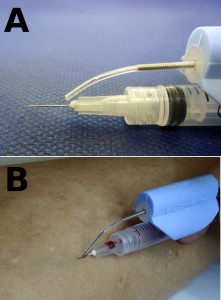Sclerotherapy for telangectasias (spider veins) is a common method of treatment. Duplex ultrasound is usually required beforehand to exclude underlying saphenous reflux because this may be contributory to recurrence. Care in identifying and selecting the feeder vessel prior to cannulation improves the immediate results. Nevertheless, recurrence may result in the need for further treatment. There is accumulating evidence that the combination of sclerotherapy and radiofrequency (RF) may improve the initial outcome.
BRUNO NAVES The RF device is based on the principle of selective thermolysis. The needle tip is first inserted into the feeding vessel. On activation the RF causes an increase in local temperature from the emission of a small electrical discharge. This is conducted along the entire vessel causing thermal damage and destruction remote from the site of insertion. Adjacent tissues are preserved because they conduct poorly and insulate, thereby achieving selective destruction of the spider vein.
The advantage of using a combination of liquid sclerotherapy and RF is that the former produces a chemical reaction to destroy the vein whilst the RF causes a thermal destruction.
We have demonstrated that the synergy of RF with conventional sclerotherapy causes a significant increase in the destructive power directed at the telangectasias. This is especially relevant to those veins which are resistant to conventional treatment. In consequence, this reduces the number of treatments required to achieve a good cosmetic result.
 A magnified view of the RF sclerotherapy device (A) and its use on a patient (B).
A magnified view of the RF sclerotherapy device (A) and its use on a patient (B).